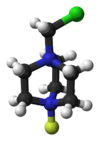Chemistry:Selectfluor
|
| |||
| Names | |||
|---|---|---|---|
| IUPAC name
1-(Chloromethyl)-4-fluoro-1,4-diazabicyclo[2.2.2]octane-1,4-diium ditetrafluoroborate
| |||
| Other names
F-TEDA, N-Chloromethyl-N-fluorotriethylenediammonium bis(tetrafluoroborate)
1-Chloromethyl-4-fluoro-1,4-diazoniabicyclo[2.2.2]octane bis(tetrafluoroborate) | |||
| Identifiers | |||
3D model (JSmol)
|
|||
| ChemSpider | |||
| EC Number |
| ||
PubChem CID
|
|||
| UNII | |||
| |||
| |||
| Properties | |||
| C7H14B2ClF9N2 | |||
| Molar mass | 354.26 g/mol | ||
| Appearance | colourless solid | ||
| Melting point | 190 °C (374 °F; 463 K) decomposes >80 °C, exact m.p. is uncertain[1] | ||
Except where otherwise noted, data are given for materials in their standard state (at 25 °C [77 °F], 100 kPa). | |||
| Infobox references | |||
Selectfluor, a trademark of Air Products and Chemicals, is a reagent in chemistry that is used as a fluorine donor. This compound is a derivative of the nucleophillic base DABCO. It is a colourless salt that tolerates air and even water. It has been commercialized for use for electrophilic fluorination.[1]
Preparation
Selectfluor is synthesized by the N-alkylation of diazabicyclo[2.2.2]octane (DABCO) with dichloromethane, followed by ion exchange with sodium tetrafluoroborate (replacing the chloride counterion for the tetrafluoroborate). The resulting salt is treated with elemental fluorine and sodium tetrafluoroborate:[2]
The cation is often depicted with one skewed ethylene ((CH2)2) group. In fact, these pairs of CH2 groups are eclipsed so that the cation has idealized C3h symmetry.
Mechanism of fluorination
Electrophilic fluorinating reagents could in principle operate by electron transfer pathways or an SN2 attack at fluorine. This distinction has not been decided.[2] By using a charge-spin separated probe,[3] it was possible to show that the electrophilic fluorination of stilbenes with Selectfluor proceeds through an SET/fluorine atom transfer mechanism.[4]
In certain cases Selectfluor can transfer fluorine to alkyl radicals.[5]
Applications
The conventional source of "electrophilic fluorine", i.e. the equivalent to the superelectrophile F+, is gaseous fluorine, which requires specialised equipment for manipulation. Selectfluor reagent is a salt, the use of which requires only routine procedures. Like F2, the salt delivers the equivalent of F+. It is mainly used in the synthesis of organofluorine compounds:[2]
Specialized applications
Selectfluor reagent also serves as a strong oxidant, a property that is useful in other reactions in organic chemistry. Oxidation of alcohols and phenols. As applied to electrophilic iodination, Selectfluor reagent activates the I–I bond in I2 molecule.[6]
References
- ↑ 1.0 1.1 Banks, R. Eric; Murtagh, Vincent; An, Ilhwan; Maleczka, Robert E. (2007). "1-(Chloromethyl)-4-fluoro-1,4-diazoniabicyclo[2.2.2]octane Bis(tetrafluoroborate)". Encyclopedia of Reagents for Organic Synthesis. doi:10.1002/047084289X.rc116.pub2. ISBN 978-0471936237.
- ↑ 2.0 2.1 2.2 Nyffeler, Paul T.; Durón, Sergio Gonzalez; Burkart, Michael D.; Vincent, Stéphane P.; Wong, Chi-Huey (2005). "Selectfluor: Mechanistic Insight and Applications". Angewandte Chemie International Edition 44 (2): 192–212. doi:10.1002/anie.200400648. PMID 15578736.
- ↑ Tojo, Sachiko; Morishima, Kazuhiro; Ishida, Akito; Majima, Tetsuro; Takamuku, Setsuo (1995). "Remarkable Enhancements of Isomerization and Oxidation of Radical Cations of Stilbene Derivatives Induced by Charge-Spin Separation". The Journal of Organic Chemistry 60 (15): 4684–4685. doi:10.1021/jo00120a004. ISSN 0022-3263.
- ↑ Brandt, Jochen R.; Lee, Eunsung; Boursalian, Gregory B.; Ritter, Tobias (2014). "Mechanism of electrophilic fluorination with Pd(iv): fluoride capture and subsequent oxidative fluoride transfer". Chem. Sci. 5 (1): 169–179. doi:10.1039/C3SC52367E. ISSN 2041-6520. PMID 24376910.
- ↑ Paquin, J.-F.; Sammis, G.; Chatalova-Sazepin, C.; Hemelaere, R. (2015). "Recent advances in radical fluorination". Synthesis 47 (17): 2554–2569. doi:10.1055/s-0034-1378824.
- ↑ Stavber, Stojan; Kralj, Petra; Zupan, Marko (2002-08-01). "Progressive Direct Iodination of Sterically Hindered Alkyl Substituted Benzenes" (in en). Synthesis 2002 (11): 1513–1518. doi:10.1055/s-2002-33339. ISSN 0039-7881.
Patents
- US patent 5459267 "1-substituted-4-fluoro-1,4-diazoniabicyclo[2.2.2]octane salts and their application as fluorinating agents"
- US patent 55227493 "Fluorinated Sulfonamide Derivatives"
- US patent 5086178 "Fluorinated Diazabicycloalkane Derivatives"
- US patent 5473065 "Fluorinated Diazabicycloalkane Derivatives"
- US patent 5442084 "Method of Selective Fluorination"
 |





